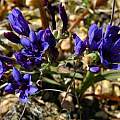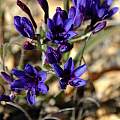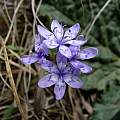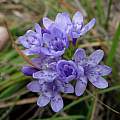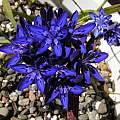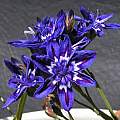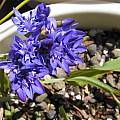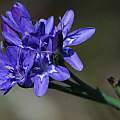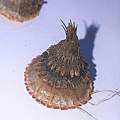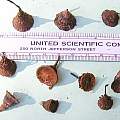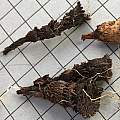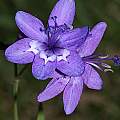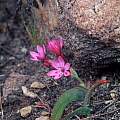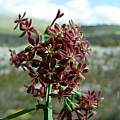Codonorhiza is a genus in the Iridaceae family described by Goldblatt and Manning in 2015 when Lapeirousia was broken into 4 genera. Lapeirousia was retained and the other two new genera described were Schizorhiza with one species and Psilosiphon. Psilosiphon was renamed in 2016 as Afrosolen. Codonorhiza species have bell-shaped corms with flat bases that are dark grey to almost black and consist of a concentric layer of compacted fibers with a broad basal lip, flowers with deeply forked style branches and green, somewhat leathery floral bracts, 2 or 3 leaves with lowermost inserted at ground level and blue, purple, pink, brown, yellow or white flowers, usually with contrasting darker or lighter markings. Unlike Lapeirousia in which the basic chromosome number is x = 8 or 9, in Codonrhiza x = 10. There are 7 species, all restricted to the Southwestern Cape, South Africa. Many of the species are short and more likely to be observed after fire or in cleared areas.
Codonorhiza azurea (Eckl. ex Baker) Goldblatt & J.C.Manning, syn. Lapeirousia azurea (Eckl. ex Baker) Goldblatt, syn. Lapeirousia corymbosa var. azurea Eckl. ex Baker, is found on sandy and granitic slopes, prominently in burned or cleared areas, in the Southwestern Cape (the Paardeberg and surroundings). It is a short plant, 7 to 18 cm high (occasionally taller), with bilaterally symmetrical and deep blue flowers with dark red or blackish markings on three tepals and dark purple or red-brown pollen. Flowers are tilted backwards. This species is in decline because of habitat loss and fragmentation. Once very common, it is now extinct on the Cape Peninsula and subpopulations are confined to small, isolated fragments. Photos were taken in the Southwestern Cape in September 2006 by Mary Sue Ittner. Interestingly this plant from a distance looks a little like Babiana angustifolia which is also found in this area.
Codonorhiza corymbosa (L.) Goldblatt & J.C.Manning, syn. Lapeirousia corymbosa (L.) Ker Gawl., is a short plant (6 to 15 cm) with two to three leaves with prominent veins. The basal leaf is usually sickle-shaped and wavy with the uppermost leaf inserted in the middle third of the stem. Flowers are radially symmetrical, pale to deep blue, rarely white, flowers borne in clusters on a much branched stalk. Flowers have a white central star edged in dark blue. This species is found on sandy and granitic slopes in the Southwestern Cape. Flowering is in late September and October, occasionally later, and especially after fire. Photos taken near Napier in the Overberg by Cameron McMaster.
The first three photos were taken by Bob Rutemoeller of plants grown from seed from Silverhill Seeds and show the great variation in color you get from seedlings. After several years of growth, there were finally flowers, but in subsequent years only an occasional flower even when there were many corms in a container. Slowly the corms dwindled. The fourth photo was taken by Mary Sue Ittner.
The first photo was taken by Margaret Fox and shows the conical corms. The second photo of the corms was taken by Mary Sue Ittner. The last photo of five year old corms on a 1 cm grid grown by M.Gastil-Buhl from Silverhill Seed shows how each year the new corm forms below the old tunic.
Codonorhiza elandsmontana Goldblatt & J.C.Manning is found in rocky ground, often in clay or clay loam, in the Tulbagh Valley, Southwestern Cape. Growing from 15 to 21 cm, it is several branched with bilaterally symmetrical flowers tilted backward in a congested false panicle. Flowers are light to dark blue or violet with a white throat and white bracket shaped bands edged in dark blue in the base of the lower tepals. Pollen is blue or grey to purple. It flowers September and October. It is similar to Codonorhiza corymbosa, but that species is radially symmetrical and has markings on all of the tepals. It is also similar to Codonorhiza azurea in its floral presentation, but is lighter in color and has different markings. Photo from Andrew Harvie.
Codonorhiza falcata (L.f.) Goldblatt & J.C.Manning, syn. Lapeirousia falcata (L.f.) Ker Gawl., syn. Lapeirousia pappei Baker, occurs on sandstone and in crevices in rock outcrops or in seeps at mid to high elevations in the Southwestern Cape. Flowering is mainly September to October at lower elevations and as late as mid-December at high elevations. Flowering is stimulated by fire. Plants are short and compact to 10 cm, with 2 leaves with the lowermost basal and falcate with the main vein raised. This species is the only one with an inflorescence in a spike. It has up to 12 bilaterally symmetrical pale pink to white flowers with dark pink to mauve or red in the lower midline on the lower 3 tepals. Photo from Rachel Saunders.
Codonorhiza fastigiata (Lam.) Goldblatt & J.C.Manning, syn. Lapeirousia corymbosa subsp. fastigiata (Lam.) Goldblatt, syn. Lapeirousia fastigiata (Lam.) Ker Gawl., grows on shale soils on hills and lower mountain slopes in renosterveld shrubland in the Southwestern Cape. Growing from 10 to 20 cm, it has a congested more or less flat topped false panicle of pale yellow to almost white radially symmetrical flowers with purple or brown median triangular marks in the basal third of each tepal. It has two leaves with prominent veins; the largest is sickle-shaped and usually wavy or crisped. It flowers late September to mid October. Photos can be viewed here.
Codonorhiza micrantha (E.Mey. ex Klatt) Goldblatt & J.C.Manning, syn. Lapeirousia manuleiflora Eckl., syn. Lapeirousia micrantha (E.Mey. ex Klatt) Baker, is found on rocky sandstone soils in fynbos from the Gifberg to Riversdale, flowering late September to December after a fire. Growing mostly from 12 to 25 cm, it has small yellow to brown to dull maroon clove scented radially symmetrical flowers in a flat topped false panicle that are borne in groups high above the curved, crisped leaves. The photo was taken by Cameron McMaster in Napier in the Overberg.
Afrosolen - Lapeirousia - Schizorhiza
